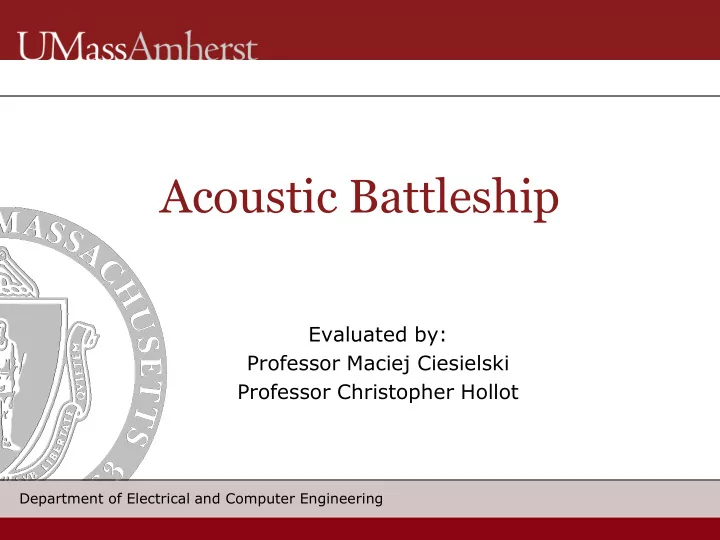

Acoustic Battleship Evaluated by: Professor Maciej Ciesielski Professor Christopher Hollot Department of Electrical and Computer Engineering
Team Members Liam Weston Adrian Sanmiguel (Group Manager) Xinyu Cao Justin Forgue Department of Electrical and Computer Engineering 2
Problem Statement Board games have failed to adapt to the technological advances of today’s market. Traditional board games have fallen out of favor. Implementing embedded systems could help to provide a jolt to the industry. How do we plan to do this? Department of Electrical and Computer Engineering 3
Problem Statement ▪ Provide an aesthetically pleasing, functional, scalable, and robust interface ▪ Applying these characteristics to Battleship Department of Electrical and Computer Engineering 4
Problem Statement ▪ Our solution will put an interactive spin on a classic game ▪ Accuracy based game using a ping pong ball to provide low-latency, responsive feedback ▪ Will follow an adapted set of guidelines to Battleship ▪ Using localization from a network of microphones to detect if a target is hit Department of Electrical and Computer Engineering 5
Game Demo Player A plays, miss Display for B Display for A Player B Player A START Department of Electrical and Computer Engineering 6
Game Demo Player B plays, hits Display for B Display for A Player B Player A Department of Electrical and Computer Engineering 7
System Requirements & Specifications Table of Requirements and Specifications Requirement Specifications Value Accuracy Distance Error <= 5 cm Responsiveness Response Time <= 500 ms Components: Microphone, LED, ADC, Microcontroller, Display, Ping-Pong Ball, transparent glass table Department of Electrical and Computer Engineering 8
Block Diagram Processing Unit UI LED Microcontroller Clock Display Input Ping Pong Ball Acoustic ADC Sensors Sound Effect Start Button Department of Electrical and Computer Engineering 9
Microphone Sensors ▪ Implement 16 electret omnidirectional condenser microphones (CMA-4544PF) to optimize source localization in 2-Dimensional space ▪ Operating frequency: 20Hz – 20kHz Frequency of human conversation: 85Hz - 255 Hz Frequency of Ping Pong hitting a surface: 5.9kHz - 7.3kHz CMA-4544PF Department of Electrical and Computer Engineering 10
Microphone Sensors ▪ Microphones sensors will be omnidirectional Department of Electrical and Computer Engineering 11
Analog Digital Converter (ADC) Department of Electrical and Computer Engineering 12
Time of Arrival Department of Electrical and Computer Engineering 13
Algorithms sound source d = t * s acoustic sensor t: time duration from sound source to sensor s = 340 m/s (sound of speed in air) d: distance from sound source to sensor Department of Electrical and Computer Engineering 14
Algorithms sound source acoustic sensor calculated coordinate: actual coordinate: ••• Three-sensor subsystem with two corner sensors Department of Electrical and Computer Engineering 15
Microcontroller Function ▪ Takes input from the ADCs and clock ▪ Once the input of an ADC goes high the system time is stored ▪ The 16 time stamps are compared to calculate a location on the board ▪ The location is matched to a LED ▪ The relevant LED is switched through the output of a PWM signal Department of Electrical and Computer Engineering 16
Technical Alternatives FPGA (compared to microcontroller) Pro: flexible and reduce system components ▪ Con: more complex and takes more time ▪ Camera vision (compared to microphone sensor) Pro: easier to track the motion, more precise ▪ Con: more complex and resource intensive. ▪ Infrared sensors (compared to microphone sensor) Pro: more accurate, more responsive ▪ Con: expensive, need a lot ▪ Department of Electrical and Computer Engineering 17
Non-Technical Alternatives Ping-Pong Score Keeping (compared to Battleship) ▪ Pro: more interesting ▪ Con: not represent the precision we are looking to achieve; more edge cases Electric Dart Game (compared to Battleship) ▪ Pro: straightforward; represent the precision ▪ Con: less technically advanced and less interesting Department of Electrical and Computer Engineering 18
Prototype Budget ▪ (16) Microphone Sensors: $15.00 ▪ Passive Components: $5.00 ▪ (1) Arduino Microcontroller: $23.00 ▪ Playing Surface: $80.00 ▪ (200) RGB LED: $56.00 ___________________________ Total: $179.00 Budget Remaining: $321.00 Department of Electrical and Computer Engineering 19
MDR Prototype ▪ System on a single board for one player ▪ Using Arduino as microcontroller ▪ Calculate coordinates and light up LED accordingly ▪ Error distance less than 8 cm. ▪ Response time less than 1 s Department of Electrical and Computer Engineering 20
Question? Department of Electrical and Computer Engineering 21
Recommend
More recommend